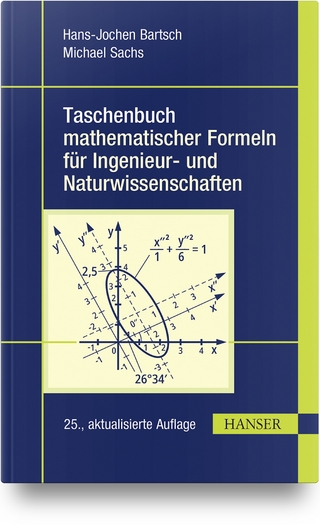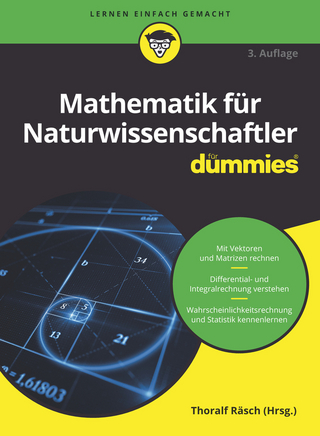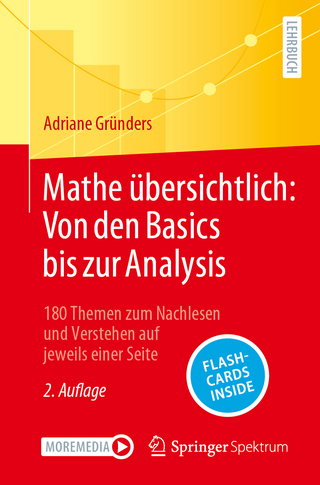
An Imaginary Tale
The Story of √-1
Seiten
2007
|
Revised edition
Princeton University Press (Verlag)
978-0-691-12798-9 (ISBN)
Princeton University Press (Verlag)
978-0-691-12798-9 (ISBN)
- Titel erscheint in neuer Auflage
- Artikel merken
Zu diesem Artikel existiert eine Nachauflage
Tells the 2000-year-old history of one of mathematics' elusive numbers, the square root of minus one, also known as i. This book weaves into the historical facts and mathematical discussions, including the application of complex numbers and functions to problems, such as Kepler's laws of planetary motion and ac electrical circuits.
Today complex numbers have such widespread practical use - from electrical engineering to aeronautics - that few people would expect the story behind their derivation to be filled with adventure and enigma. In "An Imaginary Tale", Paul Nahin tells the 2000-year-old history of one of mathematics' most elusive numbers, the square root of minus one, also known as i. He recreates the baffling mathematical problems that conjured it up, and the colourful characters who tried to solve them. In 1878, when two brothers stole a mathematical papyrus from the ancient Egyptian burial site in the Valley of Kings, they led scholars to the earliest known occurrence of the square root of a negative number. The papyrus offered a specific numerical example of how to calculate the volume of a truncated square pyramid, which implied the need for i.In the first century, the mathematician-engineer Heron of Alexandria encountered 'i' in a separate project, but fudged the arithmetic; medieval mathematicians stumbled upon the concept while grappling with the meaning of negative numbers, but dismissed their square roots as nonsense.
By the time of Descartes, a theoretical use for these elusive square roots - now called 'imaginary numbers' - was suspected, but efforts to solve them led to intense, bitter debates. The notorious i finally won acceptance and was put to use in complex analysis and theoretical physics in Napoleonic times.Addressing readers with both a general and scholarly interest in mathematics, Nahin weaves into this narrative entertaining historical facts and mathematical discussions, including the application of complex numbers and functions to important problems, such as Kepler's laws of planetary motion and ac electrical circuits. This book can be read as an engaging history, almost a biography, of one of the most evasive and pervasive 'numbers' in all of mathematics.
Today complex numbers have such widespread practical use - from electrical engineering to aeronautics - that few people would expect the story behind their derivation to be filled with adventure and enigma. In "An Imaginary Tale", Paul Nahin tells the 2000-year-old history of one of mathematics' most elusive numbers, the square root of minus one, also known as i. He recreates the baffling mathematical problems that conjured it up, and the colourful characters who tried to solve them. In 1878, when two brothers stole a mathematical papyrus from the ancient Egyptian burial site in the Valley of Kings, they led scholars to the earliest known occurrence of the square root of a negative number. The papyrus offered a specific numerical example of how to calculate the volume of a truncated square pyramid, which implied the need for i.In the first century, the mathematician-engineer Heron of Alexandria encountered 'i' in a separate project, but fudged the arithmetic; medieval mathematicians stumbled upon the concept while grappling with the meaning of negative numbers, but dismissed their square roots as nonsense.
By the time of Descartes, a theoretical use for these elusive square roots - now called 'imaginary numbers' - was suspected, but efforts to solve them led to intense, bitter debates. The notorious i finally won acceptance and was put to use in complex analysis and theoretical physics in Napoleonic times.Addressing readers with both a general and scholarly interest in mathematics, Nahin weaves into this narrative entertaining historical facts and mathematical discussions, including the application of complex numbers and functions to important problems, such as Kepler's laws of planetary motion and ac electrical circuits. This book can be read as an engaging history, almost a biography, of one of the most evasive and pervasive 'numbers' in all of mathematics.
Paul J. Nahin is the author of many best-selling popular math books, including "Digital Dice, Chases and Escapes, Dr. Euler's Fabulous Formula, When Least Is Best, Duelling Idiots and Other Probability Puzzlers," and "Mrs. Perkins's Electric Quilt" (all Princeton). He is professor emeritus of electrical engineering at the University of New Hampshire.
| List of Illustrations | ||||||||||||||||||||||||||||
| Ch. 1 | The Puzzles of Imaginary Numbers | |||||||||||||||||||||||||||
| Ch. 2 | A First Try at Understanding the Geometry of [the square root of] -1 | |||||||||||||||||||||||||||
| Ch. 3 | The Puzzles Start to Clear | |||||||||||||||||||||||||||
| Ch. 4 | Using Complex Numbers | |||||||||||||||||||||||||||
| Ch. 5 | More Uses of Complex Numbers | |||||||||||||||||||||||||||
| Ch. 6 | Wizard Mathematics | |||||||||||||||||||||||||||
| Ch. 7 | The Nineteenth Century, Cauchy, and the Beginning of Complex Function Theory | |||||||||||||||||||||||||||
| App. A | The Fundamental Theorem of Algebra | |||||||||||||||||||||||||||
| App. B | The Complex Roots of a Transcendental Equation | |||||||||||||||||||||||||||
| App. C | ([the square root of] -1)[superscript [square root of] -1] to 135 Decimal Places, and How It Was Computed | |||||||||||||||||||||||||||
| Notes | ||||||||||||||||||||||||||||
| Name Index | ||||||||||||||||||||||||||||
| Subject Index | ||||||||||||||||||||||||||||
Acknowledgments
Mehr entdecken
aus dem Bereich Buch | Hardcover (2023)
Hanser, Carl (Verlag)
29,99 €
Buch | Softcover (2023)
Springer Spektrum (Verlag)
32,99 €
| ||||||||||||||||||||||||||||



